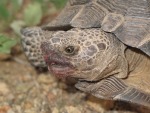 Teenage Mutant Ninja Turtles spurred an increase in the black market trade for turtles and tortoises.It’s a powerful comment on the miraculous complexity of life on earth that scientists are still regularly discovering new species. Not just plants and insects, but everything up to large mammals—and a surprising number of reptiles and amphibians. Unfortunately, there’s a hazardous downside to these herpetological discoveries: A nasty subset of herp collectors in the U.S. and Europe covet rare species to add to their menageries. Not only do these twisted individuals not care that it’s against the law to import or keep such animals, the very designation of “threatened” or “endangered” adds to the cachet of the acquisition. The rarer the better—consequences to the wild population be damned.
Teenage Mutant Ninja Turtles spurred an increase in the black market trade for turtles and tortoises.It’s a powerful comment on the miraculous complexity of life on earth that scientists are still regularly discovering new species. Not just plants and insects, but everything up to large mammals—and a surprising number of reptiles and amphibians. Unfortunately, there’s a hazardous downside to these herpetological discoveries: A nasty subset of herp collectors in the U.S. and Europe covet rare species to add to their menageries. Not only do these twisted individuals not care that it’s against the law to import or keep such animals, the very designation of “threatened” or “endangered” adds to the cachet of the acquisition. The rarer the better—consequences to the wild population be damned.
A recent BBC News story of a handsome species of newt discovered in Laos in 1999. The biologist who recorded it, Bryan Stuart, innocently published an article describing the black-and-yellow animal and its habitat. Six years after Stuart’s paper was published, the newt was nearly extinct in the wild, the result of massive collecting by locals to feed the black market pet trade.
Similar stories abound. A poison frog in Peru became a hot item, and villagers in the area began cutting down trees just to access the canopies where the frog lived.
These accounts might seem inconsequential in the large scheme of things, but the fact is, the illegal pet trade is the third largest black market in the world, after guns and drugs. Even the ostensibly legitimate side of the trade has a dark aspect. Many animals that are still legal to import are often captured and transported under cruel and unsustainable conditions. In the 1980s, the wild turtle trade experienced a huge surge due to the popularity of the show Teenage Mutant Ninja Turtles. Very few of those impulse-purchase turtles lived out a full lifespan after being given to eight-year-olds on a whim, and the effects on wild populations, while difficult to quantify, were certainly not positive.
One result of these findings is that biologists are becoming reluctant to announce the discovery of new species. It’s a desperate ploy with two edges: Keeping a new species secret might protect it from wildlife collectors, but might also prevent the designation of protected habitat, and habitat loss is an even bigger threat to threatened species than the wildlife trade. Up to now, penalties for smuggling wildlife into the U.S. have been light, and the attitude towards perpetrators dismissive. It’s time to crack down on smugglers with prison time, rather than fines which amount to little more than the proceeds from one or two successful smuggling trips.
